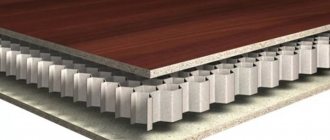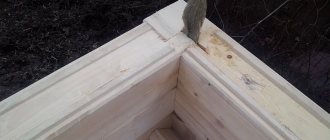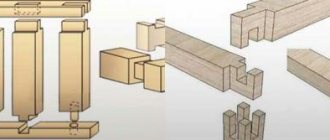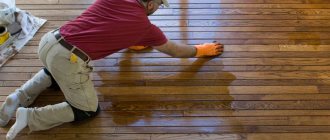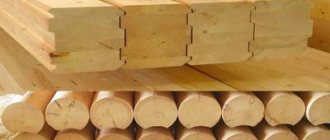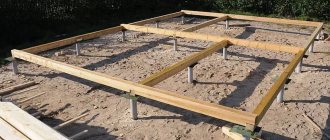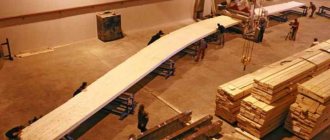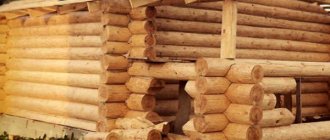Country houses are rarely built from LVL timber. It turns out to be an expensive pleasure. It differs from double timber in increased strength, reliability and more. It retains heat excellently. It is not afraid of severe frosts typical of the harsh Russian winter. Doesn't sit down. Does not deform under the influence of destructive external factors. Meets the current Russian state standard “GOST 33124-2014”. Check out its principles here. Want to know more? Read an honest review about the features, as well as the advantages and disadvantages of the building materials from which Americans built houses and cottages back in the thirties...
What is LVL timber
LVL materials appeared in 1935 in the laboratory of the US Federal Forestry. After 30 years, mass production of beams was launched in America. They are made from thin sheets of wood that are joined by gluing. The raw materials are pine, larch, spruce and other conifers.
One beam can consist of 24 layers. Typically, panels of 9 to 12 balls are used in construction.
Such materials are produced in 2 types. If the layers are in the longitudinal direction of the wood fibers, LVL beams are called structural. They are able to withstand large loads with small cross-sectional dimensions. The construction of a massive foundation is not required. The disadvantage of such timber is that the edges curl when the panel width is large.
In the structure of the second type of LVL timber, every 5th layer is laid across the remaining fibers. This provides strength to the lumber and eliminates twisting. Therefore, it is used to create doors, walls, and wide surfaces. LVL timber with different markings are available on the market.
Russian factories produce goods with the following designation:
- R, S - high-density veneer is placed parallel to the wood fibers;
- X, Q - adjacent sheets are directed perpendicular to the wood fibers;
- I - a mixture of the previous types from veneer of a lower grade;
- T - similar to S, but has fewer layers.
Material marked R is suitable for the construction of load-bearing structures, S - for replacing wooden beams. Beams marked X and I are used to build walls and partitions. Brand Q is intended for the production of roofing panels and ceilings. Lumber with a T mark is used as a joist for flooring.
Where is LVL timber used?
LVL timber is used as load-bearing elements of the frame, as we said earlier. It is used in the construction of trade pavilions, kiosks, hangars, outbuildings, security structures, non-residential and residential premises, swimming pools, and for the formwork of monolithic buildings.
In addition to construction, LVL timber is successfully used for finishing premises; it is also used to produce door frames, window frames, door leaves, furniture elements, interior partitions, etc.
Properties and performance characteristics of laminated timber LVL
The material has high strength, which is 3 times higher than that of conventional lumber. It is achieved by parallel arrangement of fibers. This is the main difference between LVL materials and plywood.
The timber has the following properties:
- Moisture resistance - humidity indicator from 8 to 12%. The timber practically does not absorb moisture. It can be used for cladding the walls of saunas and bathtubs.
- Durability - for the production of veneer, wood is selected immediately after felling. Over time, cracks do not appear on the surface, and the material does not dry out.
- Uniformity - the fibers are evenly distributed over the entire plane, which ensures the same quality of the material. There are no longitudinal or transverse deformations.
- Lightweight - weighs less than solid timber. Does not change weight even when exposed to moisture.
- Bending resistance ranges from 19 to 35 MPa, tensile strength - from 16 to 26 MPa, depending on the direction of the fibers.
- Withstands loads up to 480 kg/m2.
- Fire resistance - the material belongs to class E. Phenol-formaldehyde resin, which is used for gluing layers, does not oxidize and prevents fire. The dense structure does not allow fire and heat to penetrate the inner balls.
LVL timber does not lose its properties at a temperature of 300 degrees for 30-60 minutes. It smolders and gradually fades away.
The material does not deteriorate under the influence of aggressive substances. It is not susceptible to rotting and the influence of bacteria.
Features of choice
In order for the operational process to be long and convenient, you should pay special attention to the choice. The decisive criterion should be not only visual attractiveness, but also quality and compliance with standards.
When choosing an interior MDF door, pay attention to the following:
- Availability of a guarantee - this way you will purchase a product with a certain margin of safety, which is guaranteed by an honest manufacturer.
- The edge fits at the end - a plastic edge that fits tightly to the base material does its job best. Try to avoid paper fittings, which have high vapor permeability and do not retain vapor from phenol-formaldehyde, releasing it into the external environment.
- The quality of the coating - artificial or natural veneer, enamel or PVC - all these types of finishes will 100% perform their functions if they are of high quality and applied using technology. Do not buy products with cracks, chips, peeling material or bubbles.
- Soundproofing properties of the door - if you require sound insulation, you need to choose products with gaskets for sealing under the frame, as well as with a threshold.
- Thickness - solid MDF panels with a large weight are best installed only on load-bearing partitions, and affordable lightweight masonite panels are perfect for thin interior partitions.
MDF doors are a worthy choice for decorating a doorway in an apartment or private house. Excellent consumer properties, combined with affordable cost, ensure wide popularity of the products. A huge selection of finishing options, textures and colors make it possible to use MDF doors in any interior design.
Dimensions of LVL timber and prices
The maximum width of the beams reaches 1.8 m. At the request of the customer, they can be cut into pieces. The standard length is limited by the size of the press - 18 m. If transport does not allow transporting such boards, they are cut. Thickness ranges from 18 to 102 mm. The price for 1 m3 of material varies from 25,000 to 36,000 rubles. The cost is affected by the type of wood, the number of veneer balls and density.
In Russia there are 2 factories for the production of LVL timber: Talion-Terra in Torzhok () and LVL-Yugra in Nyagan (). Products from Finland from the company Finforest () are considered popular in Russia.
Solid non-profiled
The timber is made from a single log, with a round edge cut off on four sides. For the construction of residential buildings, as a rule, 150x150 mm naturally dried timber is used.
Pros:
- low cost;
- availability at any sawmill, that is, by choosing the nearest one, the issue of delivery of building material is easily resolved.
Minuses:
- warping, shrinkage and cracking are the disadvantages of naturally dried wood;
- wood defects - internal rot, flying knots, pests, fungus that appear after construction is completed;
- the need for additional finishing - it is not subject to finishing, therefore it needs additional finishing;
- the need for enhanced insulation of the seams - it does not have strict transverse dimensions and evenness of the cut, as a result - large gaps between the crowns;
- low manufacturability - initially it is not suitable for the construction of walls, so it is necessary to make additional strengthening of the load-bearing walls and corners of the house, and this is unnecessary labor costs and time.
The price of a solid non-profiled timber with natural humidity is about 9,500 rubles. per cubic meter Plus the cost of finishing, mandatory treatment with fire-retardant compounds and additional work.
Conclusion: not the best material for building a house, but with the right hands, patience, accuracy and attention to detail during construction, you can build a house from it, and for reasonable money.
Production technology
The production of high-quality beams is characterized by high energy costs and complexity. The process requires special equipment, so it will not be possible to make them in artisanal conditions.
The wood is selected immediately after felling. Typically, in the production of LVL timber, the thick root part of the tree is used.
The technological process includes the following stages:
Prepared logs of a certain length are sent to a bark removal machine. As a standard, a layer of 3 mm is removed.- The wood is sent for hydrothermal treatment. It is placed in pools with warm water (50 - 80 degrees) for 24 - 36 hours. Wet material is easier to peel.
- The logs are sawn into individual logs and peeled on a machine to obtain a 3 mm thick veneer.
- The produced sheets are cut into the required sizes, sorted by moisture level and sent for drying. The material must contain no more than 8% moisture.
- Finished veneer is divided by density and quality.
- An adhesive is applied to the surface and one slab of several layers of veneer is formed under a press.
- The resulting LVL bars are cut.
The process is fully automated. Density is determined using ultrasound. Color scanners are used to detect defects. The waste is used to make fuel pellets, and the bark is sent to the plant’s boiler room. At the end of production, the goods are marked and packed in film.
Are you planning to use LVL timber in construction?
Yes
No
How LVL timber is produced
The production process of LVL timber includes several stages.
First, using special equipment, the bark is removed from the tree trunk (the log is debarked). Next comes peeling, drying and sorting of the veneer. The best veneer is selected for the production of LVL timber. Without the slightest defect.
Afterwards, the veneer is glued together under a special press. The strength ratings of LVL timber are due to the fact that the veneer is glued together so that each layer is positioned so that the grains are parallel to each other.
How many layers
In LVL timber, as a rule, there can be up to 24 layers of veneer. But most often, timber is used whose thickness does not exceed 7-9 layers of veneer. The final stage of production is cutting the timber to the required dimensions and packaging it.
- The thickness of the timber may vary. In the range from 1.8 to 10.2 cm.
- The length of the beam can reach 18 meters, width - 1 -1.8 cm
Why is marriage excluded?
At each stage, the material undergoes quality control. When fed into the peeling machine, the block is scanned by a laser. The information processed on the computer is transmitted to spindle clamps, which place the tree in a position that will ensure the best yield of sheets with minimal rounding. Damage is detected by cameras and scanners at the wood cutting stage, which minimizes product defects. Layers whose humidity exceeds 8% are automatically sent to dry.
Products undergo special tests and receive confirmation of compliance with standards. Therefore, when purchasing in a store, they ask to show certificates for the goods.
Solid profiled
The timber is also made from a single log, only it is driven through special equipment, where it is given ideal geometric dimensions, a special lock profile is selected and, of course, planed to give it an aesthetic appearance.
Pros:
- low probability of warping - industrial wood drying technology makes it possible to achieve 10–15% moisture content in the final material with virtually no deformation consequences;
- does not require additional processing and finishing of the walls;
- high precision connections (no gaps);
- manufacturability - locking profiles greatly facilitate the construction process.
Minuses:
- all possible wood defects mentioned above;
- the need for additional time for shrinkage - after all, the existing possibility of shrinkage and warping of solid beams requires time for the finished walls to shrink.
- Construction from solid profiled timber
The price for a solid profiled timber kiln-drying is on average 12,000 rubles. per cubic meter More expensive than non-profiled, but the final result is much higher in quality.
Conclusion: after treatment with fire-bioprotection, subject to construction technology, it is perhaps the best choice in terms of price/quality ratio, but you must be prepared to deal with possible “surprises” of solid timber.
Advantages and disadvantages
LVL timber is suitable for construction in any weather because it does not deform under the influence of external factors. The material has the following advantages:
- the level of strength is higher compared to ordinary wood;
- not afraid of aggressive substances and humidity;
- it is not affected by rot, fungus and other bacteria;
- does not ignite in case of fire;
- high heat and sound insulation;
- lightweight and easy to build;
- does not load the foundation;
- wide range of sizes;
- absence of defects and cracks;
- allows you to implement unusual architectural solutions.
Serious disadvantages include airtightness and environmental issues. Despite meeting the standards, substances in the bonding resin may adversely affect the body. The downside is the high cost of the panels compared to other wood materials.
What kind of coating should a high-quality door leaf have?
The door covering for MDF panel determines its appearance, performance properties and price. Not only the beauty of the product will depend on the quality of the finish, but also its resistance to high levels of humidity, temperature changes, ultraviolet radiation and all kinds of mechanical stress.
Enamel
Painting interior doors made of MDF is not such a bad option as it might seem at first. Quite the contrary, this is a classic finishing option that is popular even now. A huge variety of shades and textures makes it possible to paint the canvas at a minimum cost, refresh it and fit it into a new interior without any problems. The excellent properties of the enamel coating, combined with its ease of use and affordable cost, make it popular. It is necessary to paint the door according to technology so that defects do not appear.
Eco-veneer
This is a kind of analogue of natural veneer, which is made by gluing with resins and pressing thin sections of natural wood. Next, the glued and compressed material is cut crosswise and used to finish a popular type of door.
PVC film
A film made from a polymer material can give any door leaf the required texture and shade. The coating in the form of a film is applied in a specialized chamber under the influence of high pressure and temperature. This technology will provide a uniform and high-strength coating that is resistant to various types of impacts, even on products with complex geometry and topography. PVC coating has high resistance to moisture and reasonable cost.
Veneer
The most expensive option among finishing materials. It is made from solid wood by cutting the thinnest layer. The main advantages of veneer are that the material is completely environmentally friendly and has a unique wood texture. A thin cut is applied to the door, glued and exposed to high pressure, which makes the panel durable.
Assortment of mass-produced laminated timber from LVL veneer under the Ultralam™ trademark
Ultralam is manufactured in the form of slabs and beams with a length from 2500 to 20500 mm with a gradation of 500 mm, a width from 40 to 1250 mm, a height (thickness) from 24 to 100 mm.
Maximum deviations in length are ±5 mm, in width ±2 mm. Thickness deviations: from + (0.8+0.03δ) to – (0.4+0.03δ), where δ is the thickness of the slab or beam. The cost of LVL of Ultralam™ timber does not depend on its length and cross-section. LVL timber "Ultralam"™ (trademark "Ultralam") of types
R
have the following standard linear characteristics (standard sizes):
| Thickness, mm | 30, 33, 36, 39, 45, 51, 63, 75 |
| Width (Height), mm | 120, 150, 160, 200, 220, 240, 260, 300, 360, 400, 420, 450, 500, 600, 1250 |
| Length, m | 4, 6, 8, 8.5, 9, 9.5, 10, 10.5, 12, 12.5, 13, 13.5 |
LVL timber "Ultralam"™ (trademark "Ultralam") of types X
and
I(X)
have the following standard linear characteristics (standard sizes):
| Thickness, mm | 21, 27, 30, 33, 36, 39, 45, 51, 63, 75 |
| Width (Height), mm | 120, 150, 160, 200, 220, 240, 260, 300, 360, 400, 420, 450, 500, 600, 1250 |
| Length, m | 4, 6, 8, 8.5, 9, 9.5, 10, 10.5, 12, 12.5, 13, 13.5 |
LVL timber "Ultralam"™ (trademark "Ultralam") of types I
have the following standard linear characteristics (standard sizes):
| Thickness, mm | 21, 27, 30, 33, 36, 39, 45, 51, 63, 75 |
| Width (Height), mm | 120, 150, 160, 200, 220, 240, 260, 300, 360, 400, 420, 450, 500, 600, 1250 |
| Length, m | 4, 6, 8, 8.5, 9, 9.5, 10, 10.5, 12, 12.5, 13, 13.5 |
It is possible to produce LVL timber "Ultralam"™ (trademark "Ultralam") with other linear characteristics on individual orders.


